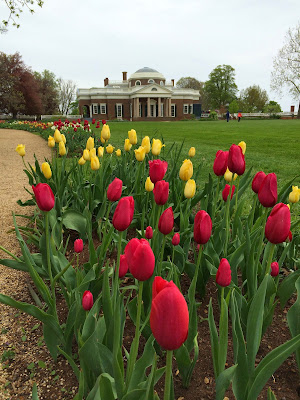It was several weeks ago now that we spent a chilly but fun weekend down in Charlottesville, VA. Our main mission there was to finally visit MONTICELLO, the fabled home of Thomas Jefferson. However, in the process, we discovered that Charlottesville itself, home of the University of Virginia and boasting a lively cultural and culinary scene, as well as plenty of wineries, orchards, and breweries--all in an idyllic, pastoral setting--was amazing as well! This first trip just whetted our appetite for more exploring there when we next get a chance.
We knew the basics about Thomas Jefferson . . . wrote the Declaration of Independence, Governor of Virginia, third President of the United States, founded the University of Virginia, spent time in Paris . . . but we had no idea of his true genius and the truly remarkable life he led outside the public eye until we saw the home he loved and the things he loved doing when he was there.
 |
| Monticello (front view) |
 |
| Monticello (rear view) |
One innovative aspect of Jefferson's design for the period was that he had all the "dependencies" (i.e., kitchen, dairy, icehouse, wine cellar, beer cellar, the laundry, etc.) below the house so they were easily accessible yet hidden from view. There was a passageway that ran underneath the house, and he constructed dumbwaiters to bring the food and drink to the upper floors of the house. (In the above picture, the dependencies were accessed underneath the terrace to the right of the house.)
 |
| Reconstructed slave cabin |
 |
| View of Monticello from West Lawn |
The pea gravel path around the West Lawn is called the "flower walk" because it is bordered by bed after bed of gorgeous flowers.
 |
| Tulips in their prime |
 |
| Pink next to yellow? Hello!! |
 |
| Fragrant lilacs |
 |
| Endless beds of flowers at their peak bloom |
The exhibitions in the Visitor Center did an excellent job of allowing visitors to interact with Jefferson's thoughts, ideas and words to gain a better understand of his intellectual pursuits and fascinations. He was extremely pragmatic, and he believed that "useful knowledge" could make life more efficient and convenient. He loved gardening, and he loved wine and beer. He loved books, and he could read in seven languages. He was passionate about music and was an accomplished violinist. He was also interested in science and was an inventor. He was a self-taught architect who designed not only his own home but also the Virginia State Capitol and the University of Virginia.
In his own words . . . here are some of our favorite Jefferson quotes:
- "I find friendship to be like wine, raw when new, ripened with age, the true old man’s milk, & restorative cordial."
- "It is neither wealth nor splendor, but tranquility & occupation which give happiness."
- "No occupation is so delightful to me as the culture of the earth, & no culture comparable..."
- "I cannot live without books."
- "The precept however is wise which directs us to ‘try all things, & hold fast that which is good.’"
Near and dear to OUR hearts, in 1803, Thomas Jefferson commissioned the Lewis and Clark Expedition in to explore the northwest territory, a.k.a. the "Corps of Discovery" that is the namesake and inspiration for our own Fourth Corps of Discovery!
Thomas Jefferson is buried on the grounds in a family cemetery plot. He died at Monticello on July 4, 1826, the 50th anniversary of American independence and also the same day his very good friend, John Adams, died at his home in Massachusetts.
A trip to Monticello wouldn't be complete without a stop down the hill for lunch at Michie's Tavern, circa 1784. The Southern fried chicken and homemade biscuits were amazing, and the accompaniments plentiful. We ate our fill of "hearty Midday Fare in a rustic tavern setting," toured the grounds and then headed back to the busier life and hectic pace up north with promises to ourselves to return and explore some more another day.




No comments:
Post a Comment